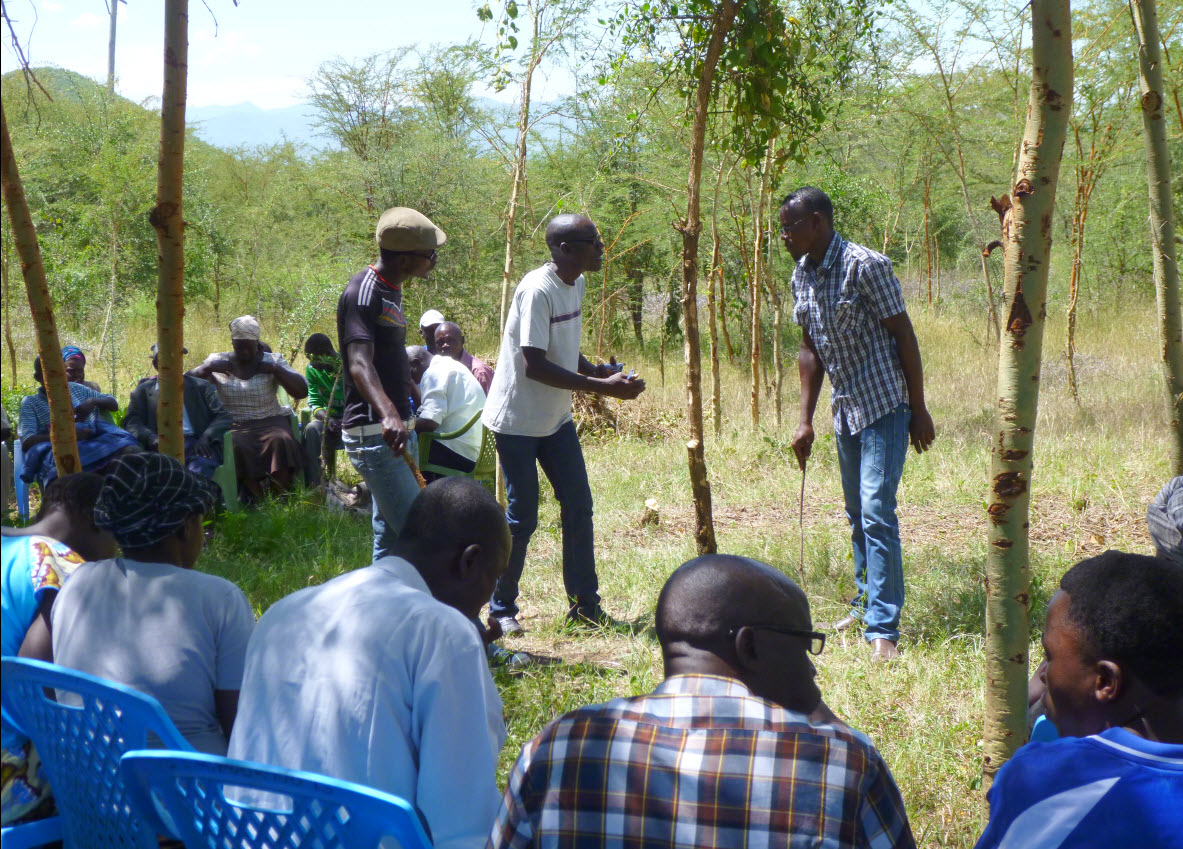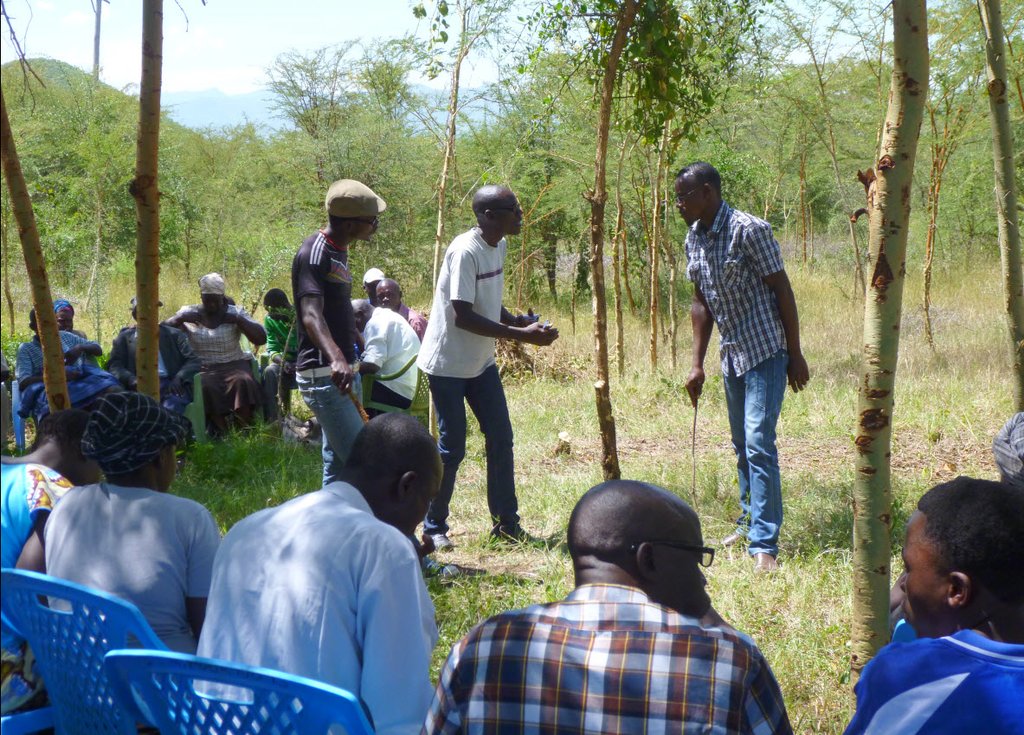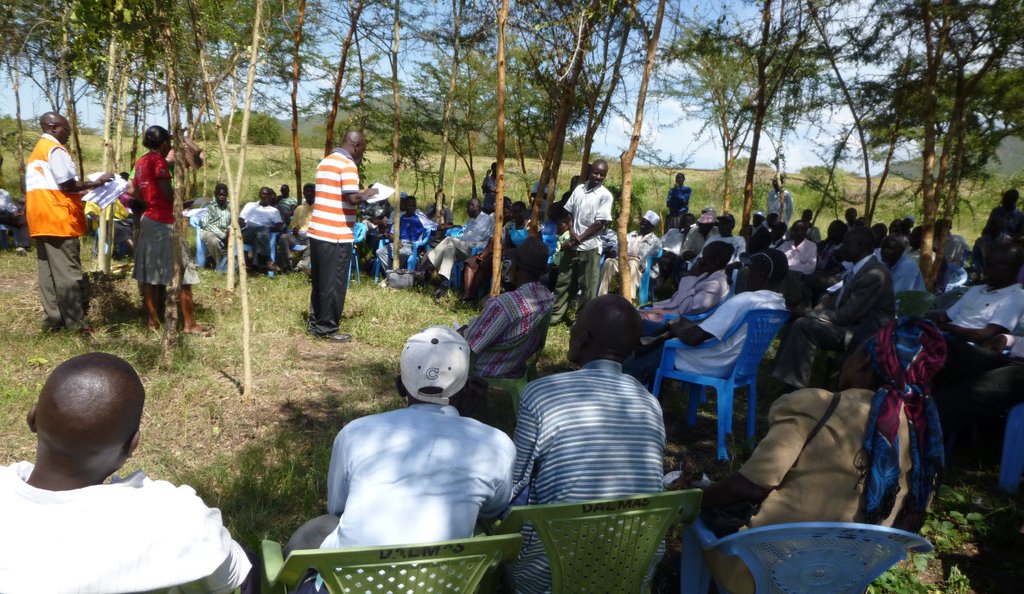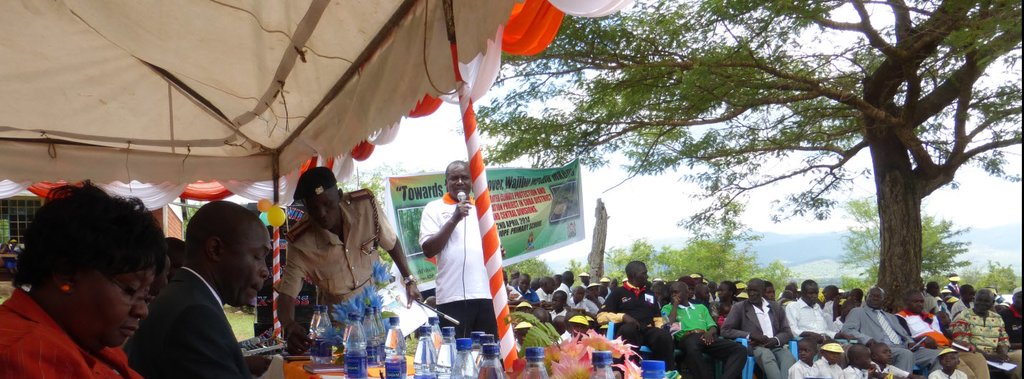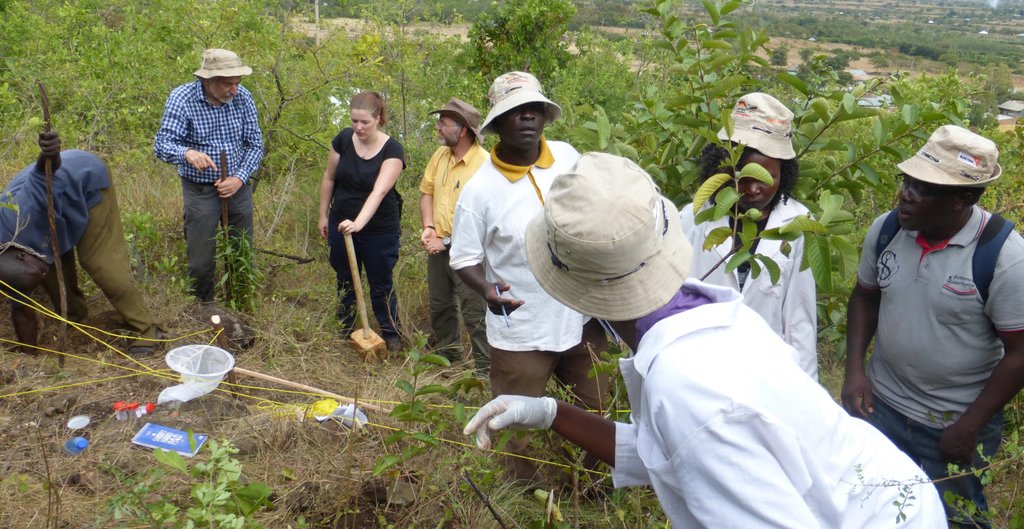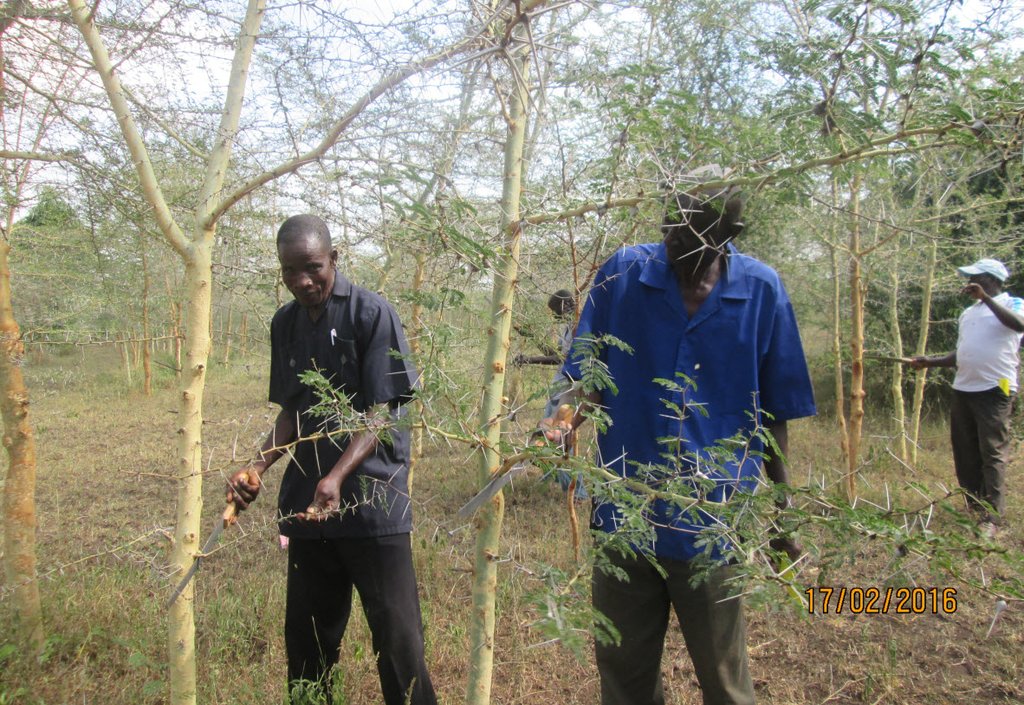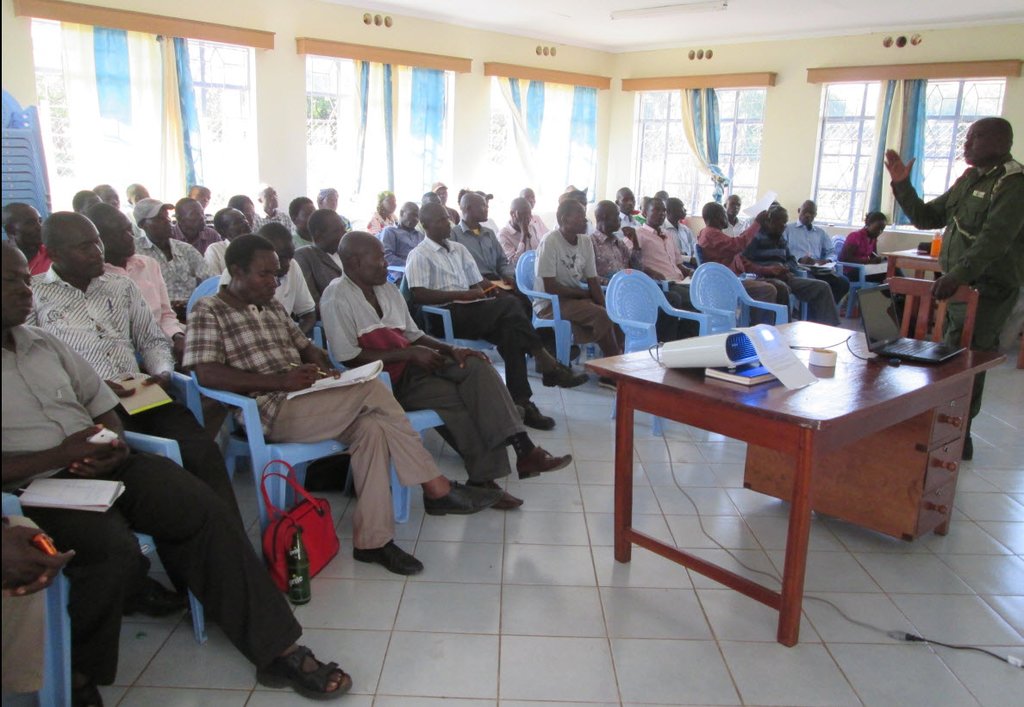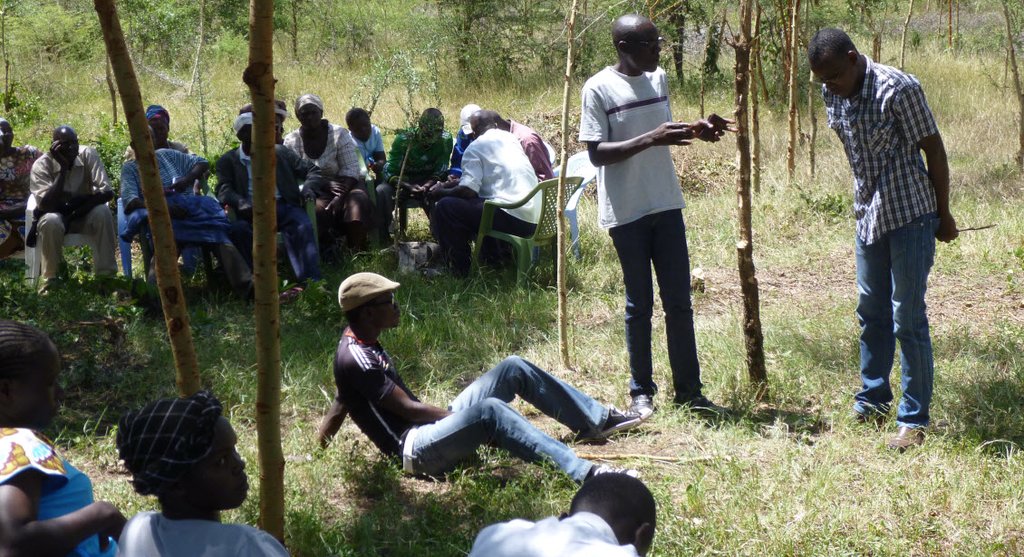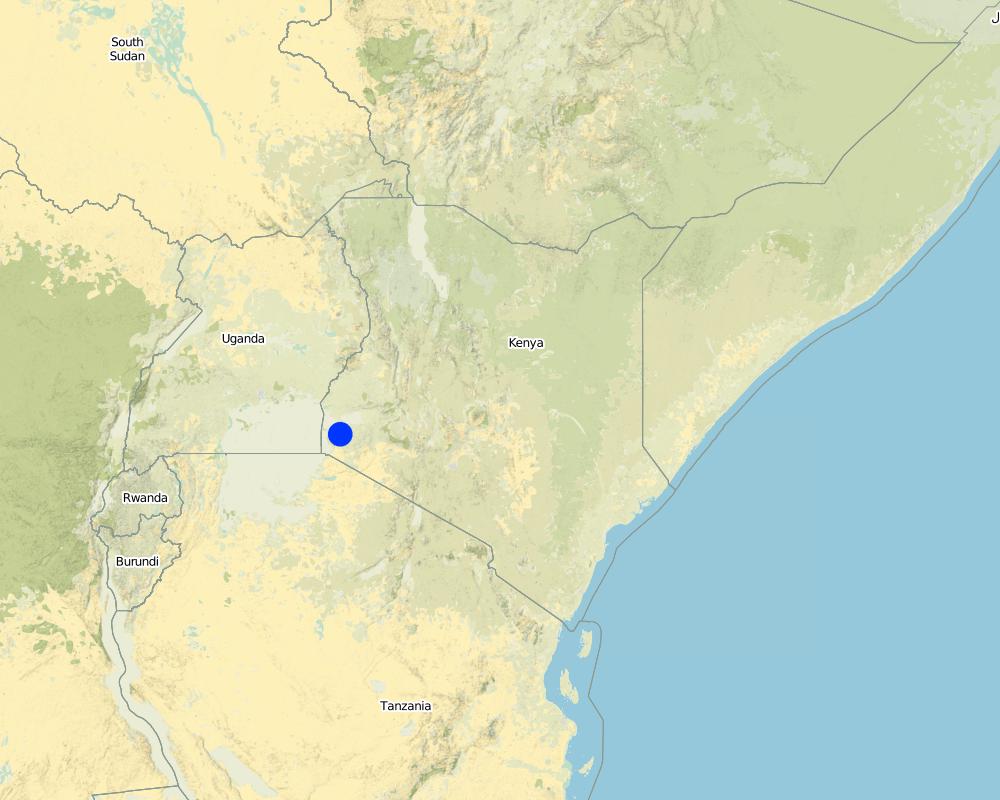FMNR implementation approach [كينيا]
- تاريخ الإنشاء:
- تحديث:
- جامع المعلومات: Thomas Kalytta
- المحرر: Irene Ojuok
- المراجعون: Alexandra Gavilano, Deborah Niggli, Hanspeter Liniger, Donia Mühlematter
FMNR nyale
approaches_733 - كينيا
عرض الأقسام
توسيع الكل طي الكل1. معلومات عامة
1.2 تفاصيل الاتصال بالأشخاص الرئيسيين لمصدر المعلومات والمؤسسات المعنية بتقييم وتوثيق النهج
الشخص (الأشخاص) الرئيسي لمصدر المعلومات
متخصص في الإدارة المستدامة للأراضي:
Ojuok Irene
+254725859689
Irene_Ojuok@wvi.org
World Vision
Lambwe Valley ADP Office, Homabay, Kenya
متخصص في الإدارة المستدامة للأراضي:
Kalytta Thomas
0041445101593
thomas_kalytta@wvi.org
World Vision
Kriesbachstrasse 30, 8600 Dübendorf, Switzerland
سويسرا
مستخدم الأرض:
Sijenyi Onyiego William
0727369635 / 708297048
n/a
Obanda Environmental project Mbita Sub County, Dr Tom Mboya Okeyos Farm along Mbita Homabay Road. The site is by the road side
اسم المشروع الذي سهّل توثيق/تقييم النهج (إذا كان ذلك على صلة)
Book project: where people and their land are safer - A Compendium of Good Practices in Disaster Risk Reduction (DRR) (where people and their land are safer)اسم المؤسسة (المؤسسات) التي سهلت توثيق/تقييم النهج (إذا كان ذلك على صلة)
World Vision (World Vision) - سويسرا1.3 الشروط المتعلقة باستخدام البيانات الموثقة من خلال WOCAT
متى تم تجميع البيانات (ميدانيا)؟:
28/11/2016
يوافق جامع المعلومات والشخص (لاشخاص) الرئيسي لمصدر المعلومات على الشروط المتعلقة باستخدام البيانات الموثقة من خلال WOCAT:
نعم
1.4 المراجع الخاصة باستبيان(استبيانات) تقنيات الإدارة المستدامة للأراضي
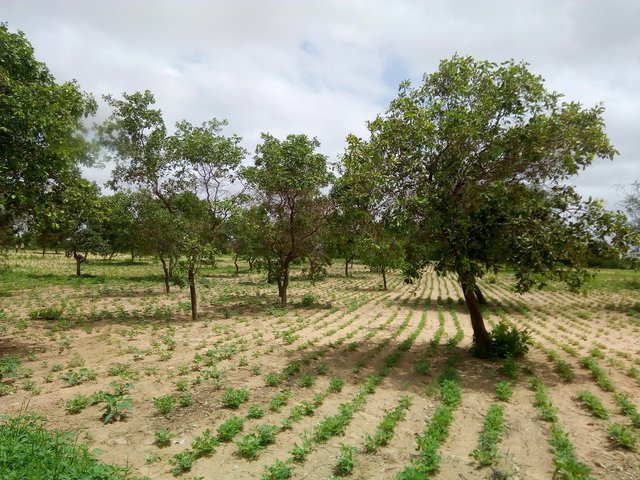
Régénération Naturelle Assistée (RNA) [السنغال]
None
- جامع المعلومات: Diaminatou SANOGO
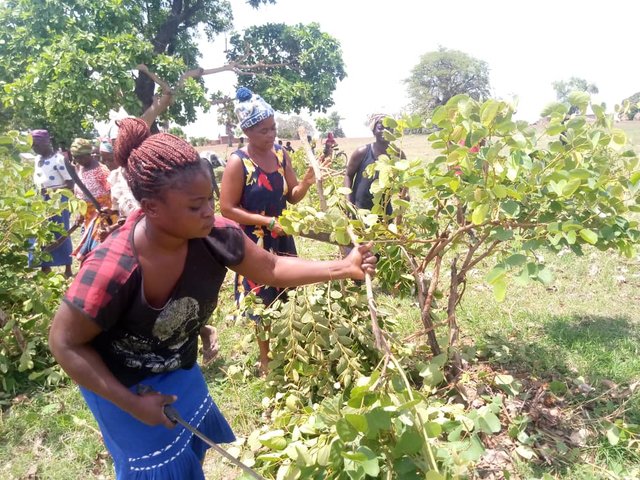
Farmer Managed Natural Regeneration(FMNR) [غانا]
Farmer Managed Natural Regeneration (FMNR) comprises a set of practices used by farmers to encourage the growth of native trees on agricultural land by systematically allowing regeneration and managing trees and shrubs from tree stumps, roots and seeds.
- جامع المعلومات: Joshua Adombire
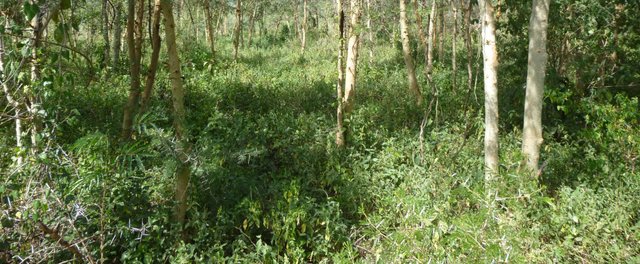
Farmer Managed Natural Regeneration (FMNR) [كينيا]
Farmer Managed Natural Regeneration (FMNR) is a proven SLM Technology to restore degraded wasteland and improve depleted farmland. The farmer regu- lates and facilitates the re-growth of existing trees stumps, or self-sown seeds in the soil, and thus promotes soil fertility and through better ground cover, increases protection from runoff …
- جامع المعلومات: Thomas Kalytta
2. وصف نهج الإدارة المستدامة للأراضي
2.1 وصف موجز للنهج
After consultations with local stakeholders, experts (from NEMA, ICRAF, KFS, Wildlife Kenya) and Homabay County Government representatives the FMNR approach is being introduced by World Vision through a public funded project. The aim of the approach is to promote FMNR and sustainable land and natural resource management through disseminating the basic idea of regenerating trees.
2.2 وصف تفصيلي للنهج
وصف تفصيلي للنهج:
The approach follows the basic principles of the of Training Trainers ToT (transfer of technology) concept i.e. key stakeholders and agents are trained to pass their knowledge on to others. Through a multi-stakeholder inception workshop all local stakeholders learn about the FMNR technology, its advantages and impacts. Representatives of the county and the national government are invited in order to get their support. Technical experts in agriculture are represented as well.
The Kenya Forest Service (KFS) and World Vision (WV) are the main actors in sensitising the local chiefs, school head teachers, CBOs, self-help groups, farmers' associations and individual farmers about FMNR, Disaster Risk Reduction and other topics. As a result farmers, teachers, schools management committee and CBO members register for the FMNR training, which is also carried out by KFS and WV. Selected farmers (those who are early adopters) are chosen as FMNR agents.
The registered FMNR practitioners (farmers, CBO members, school children, etc.) have to set aside a plot for FMNR application. They implement the technology. Each administrative unit (ward) establishes one FMNR committee under the lead of the local chief. The FMNR committee members (agents) are responsible for further dissemination for training and monitoring of the activities and maintaining the demonstration sites. They also organise exchange visits. They regularly report back to World Vision Development Facilitators. New FMNR farmers register with the committees. Research institutions (e.g. Maseno University) conduct studies to follow-up assumptions and to document change. The Community Disaster Management group is influenced by the FMNR committee and the County administration with regard to erosion control measures and gully restoration.The implementation is jointly monitored by the key stakeholders and documented by World Vision.
2.3 صور عن النهج
ملاحظات عامة بخصوص الصور:
Most of the training is done on site which practical demonstrations. 6 fenced demonstration sites and other show cases serve as pilots for the whole community.
2.4 فيديوهات عن النهج
تعليقات، وصف موجز:
A majority of East Africa community relies on agriculture and livestock production as the main source of livelihood yet these sources are experiencing challenges including environmental degradation and climate change. A number of interventions have been promoted at household level. The video teaches about the approach applied in a couple of countries in East Africa.
التاريخ:
09/04/2016
الموقع:
Kenya, Uganda, Tanzania
اسم مصور الفيديو:
World Vision
تعليقات، وصف موجز:
Video in German language
Im Kampf gegen die Dürre hat Tony Rinaudo eine simple Methode entwickelt. Anstatt Bäume zu pflanzen, greift er zur Schere und stutzt die Pflanzen, die bereits wachsen. Mit sensationellem Erfolg.
The quality is better on youtube: www.youtube.com/watch?v=tgdcbxE-OQo
التاريخ:
02/09/2016
الموقع:
Tanzania
اسم مصور الفيديو:
World Vision
2.5 البلد/المنطقة/المواقع التي تم تطبيق النهج فيها
البلد:
كينيا
المنطقة/الولاية/المحافظة:
Hombay County
مزيد من التفاصيل حول الموقع:
Suba and Mbita Sub-Counties
التعليقات:
One major demostration site is indicated only, kindly refer to the FMNR technology for more sites.
Map
×2.6 تواريخ بدء وإنهاء تنفيذ النهج
أشر إلى سنة البدء:
2014
سنة الإنهاء (إذا لم يعد النهج مطبقًا):
2017
التعليقات:
The approach of the FMNR technology was introduced by World Vision through a public funded project on climate protection and natural resource management. It received the “Total Kenya Eco Challenge Award” in 2016. The introduction was done through the following steps. The project staff were trained on the concept after which they trained Government staff in forestry, education and agriculture department including chiefs and assistant chief who were to turn out to be the entry point/ ambassadors for the concept. Intense trainings, awareness campaigns, practical demonstrations, consultative meetings and observations were conducted. Till now more than 300 hectares of degraded land was reclaimed through FMNR and over 1000 farmers adopted the practice already.
2.7 نوع النهج
- قائم على مشروع/برنامج
2.8 الغايات/الأهداف الرئيسية للنهج
The main objective of the approach is to promote FMNR and other natural resource management practices including agroforestry, crop diversification, sustainable rural energy sources and rehabilitation of highly degraded areas. It is also to utilise environmental education to advise on disaster risk reduction in order to increase the resilience of the target population against adverse effects of climate change and natural disasters.
2.9 الظروف التي تمكن أو تعيق تنفيذ التقنية/التقنيات المطبقة بموجب النهج
المعايير والقيم الاجتماعية /الثقافية/ الدينية
- تمكين/تمكيني
enabling factors are the medicinal value of trees, herbs, the importance of places for worship and local rituals,
- معيق
livestock and fire put the FMNR sites at risk, fire is sparked on hill tops to attract rain. Some neighbouring farmers also complain about the return of biodiversity especially of monkeys and snakes. Some people still maintain old traditions (clean agriculture) hindering women participating in meetings, from planting trees or working on trees in their homestead. These people are more resistant to new ideas and approaches.
توفر/الوصول إلى الموارد والخدمات المالية
- تمكين/تمكيني
natural materials can be used (wood, fruits, pods and grass) or sold, money for fire wood can be saved
الإطار المؤسساتي
- تمكين/تمكيني
some schools have surplus land which is ideal for FMNR and tree planting,
- معيق
sometimes even members of the school management board send their cows for grazing that hampers the FMNR attempts of the school children
التعاون/التنسيق بين الجهات الفاعلة
- تمكين/تمكيني
most partners are very supportive towards FMNR
الإطار القانوني (حيازة الأراضي، وحقوق استخدام الأراضي والمياه)
- معيق
a clear legal framework is lacking, the ownership of "wasteland" needs to be clear otherwise everybody tries to make benefit out of it (over grazing, charcoal burning)
السياسات
- تمكين/تمكيني
the Kenyan Government has issued a policy that 10% of the land should be covered by forest
حوكمة الأراضي (صنع القرار والتنفيذ والإنفاذ)
- معيق
young farmers complain that they have not the full rights over the family land, so they can only go for FMNR if the fathers agree. As young farmers who have not yet inherited land from their fathers according to customary laws still don’t own land which they could have long term plans. This hinders them from immediate adoption of FMNR due to land ownership rights. Mostly young men are given their share of land at about 40years. Hence this delays in uptake.
المعرفة حول الإدارة المستدامة للأراضي، والوصول إلى الدعم الفني
- تمكين/تمكيني
the Kenyan Forest Service officers were very supportive
الأسواق (لشراء المدخلات وبيع المنتجات) والأسعار
- تمكين/تمكيني
access to local markets are an advantage to sell the farm products e.g. honey is on demand, firewood, crop harvest, inputs are not very much needed apart from standard farming tool and strong gloves
عبء العمل، توفر القوى العاملة
- معيق
FMNR can create more work but the longer-term benefits are obvious. However, lazy people who are not patient will not appear to training sessions because they might not have understood the benefits of the technology.
3. المشاركة وأدوار الأطراف المعنية
3.1 أصحاب المصلحة المعنيون بالنهج وأدوارهم
- مستخدمو الأراضي المحليون/المجتمعات المحلية
small holder farmers, registered FMNR agents, DRR committees
The stakeholders were sensitised, received training, spread the message to peers and take part of the joint monitoring (agents)
- المنظمات المجتمعية
CBO and self-help groups, religious leaders (Churches), local NGOs
took part in the training, mobilised their members to adopt the practice, make links to other stakeholders,
- متخصصون في الإدارة المستدامة للأراضي / مستشارون زراعيون
agricultural extension officers (weak), Kenya Forest Service officers
the KFS officers are involved in the technical training, while the farmers have to go and access the extension officers in the towns to receive their advice
- الباحثون
Maseno University
measure the tree density, the biodiversity change on the demonstration sites
- المعلمون / أطفال المدارس / الطلاب
teachers and school children
practice FMNR and other innovative technologies
- منظمة غير حكومية
SEEK, Nature Kenya, Kenya Scouts
teach the children about environment and nature
- القطاع الخاص
The National Bank in Homabay has been supplying seedlings for tree planting in Homabay County. This was done in collaboration with Kenya Scouts. Now they show also interest in the FMNR technology.
supplied seedlings at the initial stage, show interest in FMNR as well
- الحكومة المحلية
local chiefs
mobilise their communities
- الحكومة الوطنية (المخططون، صانعو القرار)
Homabay County Government
very supportive, links to the different departments, provide match funding, take part in the joint monitoring
- منظمة دولية
World Vision, ICRAF,
technical advisor, linkage to donors
3.2 انخراط مستخدمي الأراضي المحليين/المجتمعات المحلية في المراحل المختلفة للنهج
| انخراط مستخدمي الأراضي المحليين/المجتمعات المحلية | حدد من شارك وصف الأنشطة | |
|---|---|---|
| المبادرة/التحفيز | سلبي | local farmers, DRR committee members and local chiefs were invited to take part in sensitisation sessions |
| التخطيط | تفاعلي | local chiefs very active in supporting the new technology by motivation local farmers to become registered |
| التنفيذ | تفاعلي | FMNR committees as technical support, do also monitoring and reporting |
| الرصد/التقييم | تفاعلي | done by FMNR committees, they receive data from all households jointly with other stakeholders and report back to the project management |
| research | الدعم الخارجي | done by students of the Maseno University by gathering primary data from demonstration sites very 6 months and compiling a biodiversity report |
3.3 مخطط التدفق (إذا كان متاحًا)
الوصف:
1) Through a multi-stakeholder inception workshop all local stakeholders learn about the FMNR technology, its advantages and impacts.
Representatives of the county and the national government (chiefs) are invited to get their support. Technical experts are represented as well.
2) The Kenya Forest Service and World Vision are the main actors in SENSITISING the local chiefs, school head teachers, CBOs, Self-help Groups, farmer's associations and farmers on the FMNR technology, Disaster Risk Reduction and other topics.
3) As a result farmers, teachers, schools management committee and CBO members register for the FMNR TRAINING, also carried out be KFS and WV.
Selected farmers (early adopters) are chosen as FMNR agents.
4) The registered FMNR practitioners (farmers, CBO members, school children, etc.) have to set aside a plot for FMNR application. They IMPLEMENT the technology.
5) Each administrative unit (ward) establishes one FMNR committee under the lead of the local chief
6) The FMNR committee members (agents) are responsible for further dissemination of the technology, for training and monitoring of the activities and maintaining the demonstration sites. They also organised exchange visits. They report back to World Vision Development Facilitators.
7) New FMNR farmers register with the committees (MULTIPICATION).
8) Research institutions (Maseno University) conduct studies to follow-up assumptions and to document change.
9) The Community Disaster Management group is influenced by the FMNR committee and the County administration in regard to erosion control measures and gully restoration.
10) The implementation is JOINTLY MONITORED by the key stakeholders and documented by World Vision.
11) The Chief officers of the County Government conducts additional monitoring visits.
المؤلف:
Thomas Kalytta
3.4 اتخاذ القرار بشأن اختيار تقنية/تقنيات الإدارة المستدامة للأراضي
حدد من الذي قرر اختيار التقنية/التقنيات التي سيتم تنفيذها:
- جميع الجهات الفاعلة ذات الصلة، كجزء من نهج تشاركي
اشرح:
The technology is transferred by World Vision from other African contexts. Each land-user is encouraged to try it on a piece of land. Each farmer decides whether he/she adopts it or wait and see how it develops in the neighbourhood. Demonstration plots help show case the impact and power of natural regeneration.
حدد على أي أساس تم اتخاذ القرارات:
- تقييم المعرفة الموثقة جيدًا بشأن الإدارة المستدامة للأراضي(اتخاذ القرارات القائمة على الأدلة)
- نتائج البحوث
4. الدعم الفني وبناء القدرات وإدارة المعرفة
4.1 بناء القدرات/التدريب
هل تم تقديم التدريب لمستخدمي الأراضي / الأطراف المعنيين الآخرين؟:
نعم
حدد من تم تدريبه:
- مستخدمو الأراضي
- موظفون ميدانيون/ مستشارون
إذا كان ذلك على صلة، حدد الجنس والعمر والوضع والعرق وما إلى ذلك.
there are participants list available but no time to analyse them
شكل التدريب:
- من مزارع إلى مزارع
- مناطق العرض
- اجتماعات عامة
المواضيع المغطاة:
FMNR, Natural Resource Management, Disaster Risk Reduction, Conservation Agriculture etc.
4.2 خدمة استشارية
هل يملك مستخدمو الأراضي وصولا إلى خدمة استشارية؟:
نعم
حدد ما إذا كانت الخدمة الاستشارية متوفرة:
- في حقول مستخدمي الأراضي
وصف/تعليقات:
Done by the FMNR committees and development facilitators from KFS and WV.
4.3 تعزيز المؤسسات (التطوير التنظيمي)
هل تم إنشاء أو تعزيز مؤسسات من خلال هذا النهج؟:
- نعم، إلى حد كبير
حدد المستوى (المستويات) التي تم فيها تعزيز أو إنشاء المؤسسات:
- محلي
صف المؤسسة والأدوار والمسؤوليات والأعضاء وما إلى ذلك.
schools, churches, CBOs.
حدد نوع الدعم:
- بناء القدرات/التدريب
اعط مزيدا من التفاصيل:
same as above
4.4 الرصد والتقييم
هل يشكل الرصد والتقييم جزءا من النهج؟:
نعم
التعليقات:
Yes, joint monitoring and evaluation
إذا كانت الإجابة بنعم، فهل من المقصود استخدام هذه الوثائق للمراقبة والتقييم؟:
نعم
التعليقات:
perhaps, but separate documents will be created as per donor requirement.
4.5 البحوث
هل كانت البحوث جزءًا من النهج؟:
نعم
حدد المواضيع:
- علم الايكولوجيا
- biodiversity
أعط تفاصيل إضافية وأشر إلى من قام بالبحوث:
Maseno University, botanic and zoological studies, see separate reports
5. التمويل والدعم المادي الخارجي
5.1 الميزانية السنوية لمكون الإدارة المستدامة للأراضي في النهج المذكور
أشر إلى ميزانية النهج السنوية لمكون الإدارة المستدامة للأراضي بالدولار الأمريكي:
9230,00
إذا لم تكن الميزانية السنوية الدقيقة معروفة، قم بالإشارة إلى نطاقها:
- 10,0000-2,000
التعليقات (على سبيل المثال المصادر الرئيسية للتمويل/الجهات المانحة الرئيسية):
The initiative is funded by public donors and co-funded by the county government. For the approach including awareness, campaigns, training and monitoring as well as exposure trips 9230 USD were budgeted per year.
5.2 الدعم المالي/المادي المقدم لمستخدمي الأراضي
هل حصل مستخدمو الأراضي على دعم مالي/ مادي لتنفيذ التقنية/ التقنيات؟:
نعم
إذا كانت الإجابة بنعم، حدد نوع (أنواع) الدعم والشروط والمزودين:
transport to the demo sites, for local farmers and stakeholders, food during the training, materials for sensitisation, training & monitoring, accommodation only during exposure trips
5.3 إعانات لمدخلات محددة (بما في ذلك العمالة)
- غير موجود
إذا كان العمل من قبل مستخدمي الأراضي مدخلاً جوهريًا، فهل كان:
- تطوعي
5.4 الائتمان
هل تم توفير ائتمان في إطار نهج أنشطة الإدارة المستدامة للأراضي؟:
كلا
5.5 حوافز أو وسائل أخرى
هل تم استخدام حوافز أو أدوات أخرى لتشجيع تنفيذ تقنيات الإدارة المستدامة للأراضي؟:
كلا
6. تحليل الأثر والتصريحات الختامية
6.1 آثار النهج
هل ساهم النهج في تمكين مستخدمي الأراضي المحليين وتحسين مشاركة الأطراف المعنية؟:
- لا
- نعم، قليلا
- نعم، باعتدال
- نعم، إلى حد كبير
As it connect the different actors and levels.
هل مكّن النهج من اتخاذ القرارات المبنية على الأدلة؟:
- لا
- نعم، قليلا
- نعم، باعتدال
- نعم، إلى حد كبير
Evidence can be easily seen by the great replication effect among the land users of the area.
هل ساعد النهج مستخدمي الأراضي على تنفيذ وصيانة تقنيات الإدارة المستدامة للأراضي؟:
- لا
- نعم، قليلا
- نعم، باعتدال
- نعم، إلى حد كبير
Yes, because the land users have now access to local technical experts (FMNR agents) and demonstration farms.
هل نجح النهج في تحسين التنسيق والتنفيذ الفعال من حيث التكلفة لأنشطة الإدارة المستدامة للأراضي؟:
- لا
- نعم، قليلا
- نعم، باعتدال
- نعم، إلى حد كبير
Yes, greatly, as FMNR committees were established which coordinate the implementation in each ward in a cost effective way.
هل نجح النهج في تعبئة/تحسين الوصول إلى الموارد المالية لتنفيذ الإدارة المستدامة للأراضي؟:
- لا
- نعم، قليلا
- نعم، باعتدال
- نعم، إلى حد كبير
No, the SLM itself creates sources of income but the approach doesn't mobilise funds only knowledge.
هل أدى النهج إلى تحسين معرفة وقدرات مستخدمي الأراضي على تنفيذ الإدارة المستدامة للأراضي؟:
- لا
- نعم، قليلا
- نعم، باعتدال
- نعم، إلى حد كبير
Yes, greatly.
هل أدى النهج إلى تحسين معرفة وقدرات الأطراف المعنية الأخرى؟:
- لا
- نعم، قليلا
- نعم، باعتدال
- نعم، إلى حد كبير
Yes, as it brings all relevant stakeholders together especially during the initiation and monitoring.
هل ساهم النهج في بناء/تعزيز المؤسسات والتعاون بين الأطراف المعنية؟:
- لا
- نعم، قليلا
- نعم، باعتدال
- نعم، إلى حد كبير
There is quite some exchange and strengthening among the stakeholders. Part of them are local NGOs, CBOs and churches.
هل ساهم النهج في التخفيف من حدة الصراعات؟:
- لا
- نعم، قليلا
- نعم، باعتدال
- نعم، إلى حد كبير
Yes, a little, as it brings the local stakeholders together where they can talk and solve conflict e.g. between livestock keepers and farmers.
هل ساهم النهج في تمكين الفئات المحرومة اجتماعيا واقتصاديا؟:
- لا
- نعم، قليلا
- نعم، باعتدال
- نعم، إلى حد كبير
Yes, a little, as even farmers with very small plots can raise their voices and get ideas how to increase the productivity.
هل أدى النهج إلى تحسين المساواة بين الجنسين وتمكين النساء والفتيات؟:
- لا
- نعم، قليلا
- نعم، باعتدال
- نعم، إلى حد كبير
Women are included in the discussions and training. They get empowered as the households produce fire wood which saves a lot of time for the collection. Some can also sell surplus fire wood. High yield from the farms with trees address food security. Ensuring there is food in a household is always the woman's responsibility.
هل شجع النهج الشباب/الجيل القادم من مستخدمي الأراضي على الانخراط في الإدارة المستدامة للأراضي؟:
- لا
- نعم، قليلا
- نعم، باعتدال
- نعم، إلى حد كبير
Yes, very much. During the discussions the young generation raises their voice and discuss with their fathers how to improve the land-use and productivity.
هل أدى النهج إلى تحسن في مسائل حيازة الأراضي / حقوق المستخدمين التي أعاقت تنفيذ تقنيات الإدارة المستدامة للأراضي؟:
- لا
- نعم، قليلا
- نعم، باعتدال
- نعم، إلى حد كبير
Maybe a little, as these issues can be discussed during the gatherings.
هل أدى هذا النهج إلى تحسين الأمن الغذائي / تحسين التغذية؟:
- لا
- نعم، قليلا
- نعم، باعتدال
- نعم، إلى حد كبير
Since the approach led to the implementation of FMNR and FMNR increases the production and promotes diversification the land-use types.
هل أدى النهج إلى تحسين الوصول إلى الأسواق؟:
- لا
- نعم، قليلا
- نعم، باعتدال
- نعم، إلى حد كبير
هل أدى النهج إلى تحسين الوصول إلى المياه والصرف الصحي؟:
- لا
- نعم، قليلا
- نعم، باعتدال
- نعم، إلى حد كبير
Not the approach but the related technology.
هل أدى النهج إلى استخدام طاقة/ مصادر طاقة أكثر استدامة؟:
- لا
- نعم، قليلا
- نعم، باعتدال
- نعم، إلى حد كبير
Not the approach but the related technology. The FMNR campaigns are always integrated with promotions for solar and improved cookstoves and the farmers uptake for clean energy has improved through this. It thus leads to sustainable use of energy indirectly.
هل أدى النهج إلى تحسين قدرة مستخدمي الأراضي على التكيف مع التغيرات المناخية/الظواهر المناخية المتطرفة والتخفيف من الكوارث المرتبطة بالمناخ؟:
- لا
- نعم، قليلا
- نعم، باعتدال
- نعم، إلى حد كبير
Yes, the approach increases the knowledge of the farmers on Climate change and provides options to adapt better. They now appreciate the indeginous tree species and their value and ability to survive in changing climatic conditions.
Not the approach but the related technology.
6.2 المحفز الرئيسي لقيام مستخدمي الأراضي بتنفيذ الإدارة المستدامة للأراضي
- زيادة الإنتاج
crop production, e.g. increase from 5 to 8 bags of maize/unit. More wood is obtained from FMNR sites because of biomass increase. Honey production is possible. Fodder production and others.
- زيادة الربح (القدرة)، وتحسين نسبة التكلفة إلى العائد
FMNR has provided additional/ alternative sources of income to the beneficiaries. Sale from wood, honey, medicinal components and non-wood products etc. This has led to a diversification of income. The farmer can sell more products and make more profit.
- الحد من تدهور الأراضي
Areas with deep gullies could be restored through the application of FMNR. There is clear evidence that the technology has a high potential to rehabilitate degraded ecosystems.
- الحد من مخاطر الكوارث
FMNR also serves to mitigate the impact of annual floods to the crops and settlements. FMNR also improves the micro climate and water availability. That can make an important difference for the yields in years of drought. The trees also act as strong windbreakers thus minimizing disasters related to strong winds like blowing of roofs that is rampant.
- الوعي البيئي
FMNR is being discussed and applied on the background of the huge land degradation and deforestation of the area that has seriously affected biodiversity, soil fertility and water availability.
- تعزيز المعرفة والمهارات في مجال الإدارة المستدامة للأراضي
The approach aims at promoting knowledge and skills on FMNR - an effective SLM technology.
- تحسينات جماليية
The technology covers barren soil and bleak areas. I can contribute to attract more tourists to the area.
- reduced soil ersosion
Farmers realised that they lost fertile soil in the recent decades due to increasing soil and wind erosion. FMNR protects the soil, improves the micro-climate and nutritious content of the soil.
- grass production for fodder and roofing
In dry spells the farmers lack pastures for their livestock. Grass production is an important coping mechanism to bridge these times. Some types of grass are also needed to cover traditional roofs and huts. Grass production is often promoted on larger school compounds. It can create additional income for school improvements or orphan support if the community respects the rules.
6.3 استدامة أنشطة النهج
هل يمكن لمستخدمي الأراضي المحافظة على استدامة ما تم تنفيذه من خلال النهج (بدون دعم خارجي)؟:
- نعم
إذا كانت الإجابة بنعم، صف كيف:
The local FMNR agents are well known in the community as environmentalists. They have demonstration sites on their farms. They took part in FMNR campaigns and training. Every visitor gets attracted by the technology. The agents introduce them. By applying the new technology their neighbours see and learn about FMNR as well. Even on other occasions in the community e.g funerals, religious meetings, ceremonies, the agents use the opportunity to reach more people with FMNR.
6.4 نقاط قوة/مزايا النهج
| نقاط القوة/ المزايا/ الفرص من وجهة نظر مستخدمي الأراضي |
|---|
| Sensitisation is integrated in community meetings or gatherings which bring many people together. Some of the meetings are called by local administrators who were the first champions of FMNR so this helps in infusing the knowledge through the sessions. Implementation is mostly by seeing and doing. Many farmers are consciously or subconsciously adopting FMNR as they see the sites in their neighbourhood. As the farmers visit each other alongside other engagements, FMNR monitoring continues since the people like to share new things with their friends and what they have learned. |
| نقاط القوة/ المزايا/ الفرص من وجهة نظر جامع المعلومات أو غيره من الاشخاص الرئيسيين لمصدر المعلومات |
|---|
| The ToT approach by working with FMNR agents and a local FMNR committee bridges the gap brought about by the absence of agricultural extension workers - only a few farmers actually visit them in their office in town. Also the day-by-day monitoring is done b y the FMNR committee members and not by the project staff alone. A big advantage is the support of the Kenya Forest Service officers. They were ready to help with the on-site training. Crucial for the success of any approach is to involve and win over the local chiefs. They really have understood the benefits and even try to apply the technology themselves. |
6.5 نقاط الضعف/ العيوب في المنهج وطرق التغلب عليها
| نقاط الضعف/ المساوىء/ المخاطر من وجهة نظر مستخدم الأراضي | كيف يمكن التغلب عليها؟ |
|---|---|
| Lazy people who are not patient will not appear to training sessions because they might not have understood the benefits of the technology. | Continuous engagements and ensuring the sites are at strategic places where all farmer can see them easily. These people can be convinced through the success of others. |
| The approach seeks the support of all levels (County and local government, CBOs, local farmers, schools etc.) so it is quite time consuming and requires skilled personal as facilitators. | A donor needs to take this into account in terms of available budget and life time of the project. |
| نقاط الضعف/ المساوىء/ المخاطر من وجهة نظر جامع المعلومات أو غيره من الاشخاص الرئيسيين لمصدر المعلومات | كيف يمكن التغلب عليها؟ |
|---|---|
| Some people still maintain old traditions (clean agriculture) hindering women participating in meetings, from planting trees or working on trees in their homestead. These people are more resistent to new ideas and approaches. | The tradition is being demystified especially with the church leaders and with more exposure. This might change their thinking. |
7. المراجع والروابط
7.1 طرق جمع/مصادر المعلومات
- زيارات ميدانية، مسوحات ميدانية
3 field visits
- مقابلات مع مستخدمي الأراضي
2 interview
- مقابلات مع المتخصصين/الخبراء في الإدارة المستدامة للأراضي
3 Skype calls
- التجميع من التقارير والوثائق الأخرى الموجودة
4 reports
7.2 المراجع للمنشورات المتاحة
العنوان، المؤلف، السنة، النظام القياسي الدولي لترقيم الكتب ISBN:
Farmer-Managed Natural Regeneration Enhances Rural Livelihoods in Dryland West Africa, Weston, Peter, Reaksmey Hong, Carolyn Kaboré & Christian A. Kull, Environmental Management Volume 55, Issue 6, pp 1402–1417,2015, ISBN 0364-152X00267-015-0469-1
متاح من أين؟كم التكلفة؟:
Springer, USD 35
العنوان، المؤلف، السنة، النظام القياسي الدولي لترقيم الكتب ISBN:
Re-greening the Sahel: farmer-led innovation in Burkina Faso and Niger, Reij, C.; Tappan, G.; Smale, M., in Millions fed : proven successes in agricultural development, 2009, ISBN 9780896296619
متاح من أين؟كم التكلفة؟:
International Food Policy Research Institute
7.3 روابط للمعلومات ذات الصلة المتوفرة على الإنترنت
العنوان/الوصف:
Farmer Managed Natural Regeneration Hub
عنوان الرابط URL:
http://fmnrhub.com.au/
العنوان/الوصف:
Der Waldmacher. Der Agrarexperte Tony Rinaudo verwandelt abgeholzte Steppen in grüne Wälder. Seine Methode könnte für Afrika bedeutender werden als Milliarden von Dollar Entwicklungshilfe.
عنوان الرابط URL:
http://www.tagesanzeiger.ch/wissen/natur/der-waldmacher/story/26739960
الروابط والوحدات المواضيعية
توسيع الكل طي الكلالروابط

Régénération Naturelle Assistée (RNA) [السنغال]
None
- جامع المعلومات: Diaminatou SANOGO

Farmer Managed Natural Regeneration(FMNR) [غانا]
Farmer Managed Natural Regeneration (FMNR) comprises a set of practices used by farmers to encourage the growth of native trees on agricultural land by systematically allowing regeneration and managing trees and shrubs from tree stumps, roots and seeds.
- جامع المعلومات: Joshua Adombire

Farmer Managed Natural Regeneration (FMNR) [كينيا]
Farmer Managed Natural Regeneration (FMNR) is a proven SLM Technology to restore degraded wasteland and improve depleted farmland. The farmer regu- lates and facilitates the re-growth of existing trees stumps, or self-sown seeds in the soil, and thus promotes soil fertility and through better ground cover, increases protection from runoff …
- جامع المعلومات: Thomas Kalytta
الوحدات المواضيعية
لا يوجد وحدات مواضيعية


